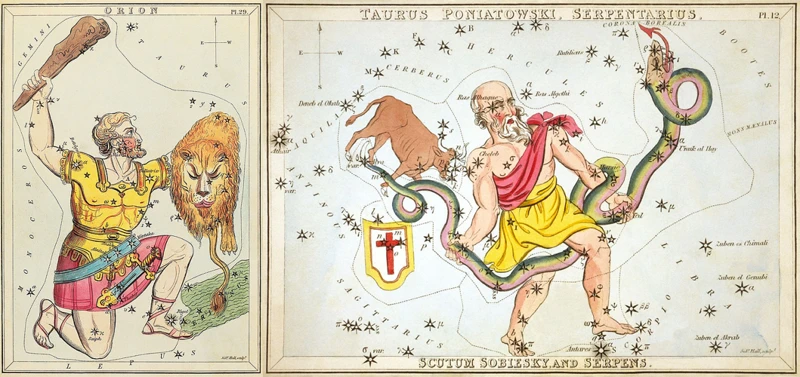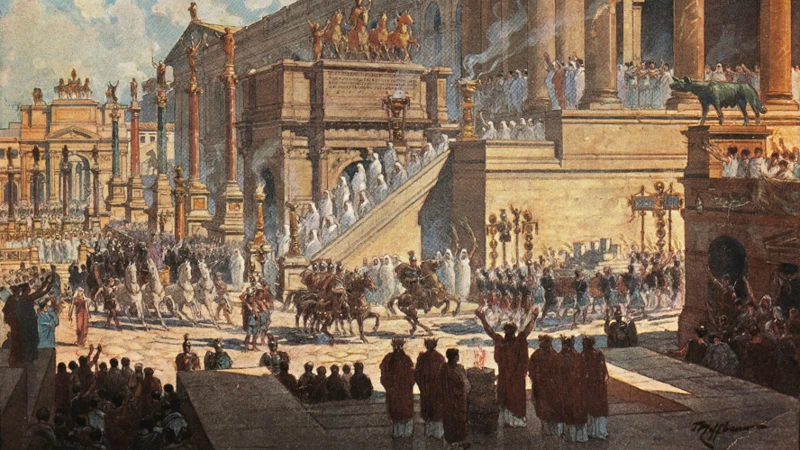The Roman Empire, with its rich history and legacy, continues to captivate the minds of people around the world. From its humble beginnings as a small settlement on the banks of the Tiber River, Rome grew into a mighty empire that dominated much of Europe, North Africa, and the Near East. However, like all great empires, the rise and fall of the Roman Empire is a complex and multifaceted story. In this article, we will delve into the fascinating journey of this ancient civilization, exploring its founding, expansion, and ultimate decline. Join us on a captivating journey through time as we unravel the mysteries and explore the triumphs and tribulations of one of history’s greatest empires.
Contents
- Founding of Rome
- Expansion and Domination
- Pax Romana
- Crises and Decline
- Legacy of the Roman Empire
- Conclusion
-
Frequently Asked Questions
- 1. What were the main factors that led to the founding of Rome?
- 2. How did the early Romans establish their government?
- 3. What were some of the early challenges faced by Rome?
- 4. Who were the major rivals of Rome during its early years?
- 5. How did Rome manage to expand its territory?
- 6. What led to the transformation from a republic to an empire?
- 7. What were some significant achievements of the Roman Empire?
- 8. What factors contributed to the decline of the Roman Empire?
- 9. How did the fall of the Roman Empire impact subsequent civilizations?
- 10. What is the legacy of the Roman Empire in modern times?
- References
-
Frequently Asked Questions
- What were the major factors that led to the founding of Rome?
- How did Rome expand its territory and become a dominant empire?
- What role did Julius Caesar play in the rise of the Roman Empire?
- What was the Pax Romana and what were its defining characteristics?
- What were the golden age achievements of Augustus during the Pax Romana?
- What were some of the engineering marvels of the Roman Empire?
- What were the major sources of political instability in the Roman Empire?
- How did the barbarian invasions contribute to the decline of the Roman Empire?
- What were the economic factors that led to the fall of the Western Roman Empire?
- What is the lasting legacy of the Roman Empire?
- References
- Read More
Founding of Rome

The marks the beginning of an empire that would leave an indelible mark on history. According to the legendary tale, Rome was founded in 753 BCE by twin brothers Romulus and Remus. The story goes that they were abandoned as infants and raised by a she-wolf. As they grew older, they decided to build a city on the spot where they were found. However, disagreement arose between the brothers over who would rule the city. In a tragic turn of events, Romulus killed Remus and became the first king of Rome. This mythological tale served as a foundation for the early Roman identity and the idea of power struggles being an inherent part of their destiny. While the founding of Rome is steeped in myth and legend, archaeological evidence suggests that the city did indeed emerge as a settlement in the 8th century BCE. The location of Rome, strategically situated on the Tiber River, provided a natural crossing point and trade route, making it an ideal location for settlement and future expansion.
Expansion and Domination

The expansion and domination of the saw Rome evolve from a small city-state into a formidable empire. With a combination of military prowess and political astuteness, Rome embarked on a conquest that shaped the course of world history. The first phase of expansion focused on the conquest of Italy itself. Through a series of wars and alliances, Rome gradually gained control over neighboring tribes and city-states, solidifying its power and influence in the region. This internal consolidation paved the way for Rome to expand beyond the Italian peninsula and into the Mediterranean. The Punic Wars against Carthage, a powerful naval empire in North Africa, marked a significant turning point in Rome’s rise to dominance. The famous general Hannibal, known for his ingenious military tactics, posed a formidable challenge to Rome. However, Rome persevered and ultimately emerged victorious, gaining control over Carthage’s territories and establishing itself as the leading power in the Mediterranean. The conquest of Greece further solidified Rome’s authority, bringing with it a cultural renaissance as Roman society absorbed and assimilated Greek art, philosophy, and literature. The expansion was not limited to military conquests alone; Rome also skillfully employed diplomatic strategies, engaging in alliances and negotiations to strengthen its position. The ability to integrate conquered territories into a cohesive administrative structure was a key component of Rome’s success. The empire was divided into provinces, each governed by a proconsul who oversaw administration, taxation, and the enforcement of Roman law. This efficient and organized system allowed Rome to maintain control over vast territories and diverse populations. As the Roman Empire continued to expand, its influence and dominion extended across three continents – Europe, Africa, and Asia. Through a combination of military might, strategic alliances, and administrative prowess, Rome was able to achieve a level of domination unmatched by any previous civilization.
Conquest of Italy
The played a pivotal role in the expansion of the early Roman Republic. In the 5th and 4th centuries BCE, Rome embarked on a series of military campaigns to establish dominance over the Italian peninsula. Through a combination of diplomacy, alliances, and military force, Rome gradually gained control over neighboring city-states and tribes, extending its sphere of influence. One of the key conflicts during this period was the Roman conquest of Veii, a powerful Etruscan city located near modern-day Rome. The siege of Veii lasted for ten years (406-396 BCE) and marked a significant turning point in Rome’s rise to power. The victory over Veii not only expanded Roman territory but also brought considerable wealth and resources to the growing republic. Rome’s conquest of Italy was not without resistance, as many tribes fiercely resisted Roman encroachment. One notable example is the Samnite Wars (343-290 BCE), a series of conflicts between Rome and the Samnites, a formidable Italic people. These wars tested Rome’s military prowess and strategic capabilities, but ultimately Rome emerged victorious and solidified its control over central and southern Italy. The conquest of Italy laid the foundation for future Roman expansion and set the stage for the rise of the Roman Empire.
Expansion into Mediterranean
The expansion of the Roman Empire into the Mediterranean region was a crucial turning point in its history. With a strong and disciplined military, the Romans embarked on a series of conquests that would shape the future of the empire. One of the earliest conquests came in 264 BCE when Rome engaged in a series of wars known as the Punic Wars against the powerful city-state of Carthage. Rome emerged victorious after three devastating wars, gaining control of Sicily, Sardinia, and Corsica in the process. This victory allowed Rome to establish a strong presence in the Mediterranean and marked the beginning of its territorial expansion. As Rome continued to expand, it encountered various other civilizations and cultures, each with its unique influences and challenges. The conquest of Greece, for example, brought the Romans into contact with the rich Hellenistic culture and led to a period of cultural assimilation known as Roman Hellenism. The Romans also faced formidable opponents in the east, such as the Seleucid Empire and the Kingdom of Pontus, but eventually conquered these regions as well. This expansion into the Mediterranean not only brought wealth and resources to Rome but also exposed the empire to a diverse range of ideas, customs, and religions.
Julius Caesar and Rise of the Roman Empire
The played a pivotal role in the rise of the Roman Empire. Born in 100 BCE, Julius Caesar was a charismatic and ambitious leader who would eventually become one of Rome’s most renowned figures. He rose to prominence as a military general, gaining victories in Gaul and Britain, which expanded Rome’s territory and brought immense wealth to the city. Caesar’s military brilliance and political acumen allowed him to establish himself as a powerful figure in Roman politics. In 49 BCE, he famously crossed the Rubicon River with his army, sparking a civil war against the Roman Senate. This act marked a point of no return, as it was considered treason to bring armed forces into Italy. Caesar emerged victorious, and in 46 BCE, he was declared “dictator perpetuo” (dictator in perpetuity), effectively granting him supreme power over Rome. During his rule, Caesar implemented a number of significant reforms, including the Julian calendar, which is still used in modified form today. His attempts at bringing social and political stability to Rome were met with resistance, leading to his assassination on the Ides of March, 44 BCE. While his life ended dramatically, Caesar’s legacy continued to shape the course of Roman history. His death ignited a power struggle that ultimately resulted in the rise of another prominent figure, Caesar Augustus, who would establish the Roman Empire and usher in a period of relative peace and stability known as the Pax Romana.
Pax Romana

The , or Roman Peace, was a period of relative stability and prosperity in the Roman Empire that spanned from 27 BCE to 180 CE. Under the principate of Augustus, the first emperor of Rome, a system of centralized government and administration was established, setting the stage for a golden age of peace and prosperity. During this time, the Roman Empire experienced significant cultural and economic growth. Artistic expression flourished, with impressive works of sculpture and architecture being commissioned. The construction of iconic structures like the Colosseum and the Pantheon showcased the engineering marvels of the empire. This period also witnessed the development of Roman law, which served as a foundation for legal systems in many parts of the world today. The empire saw advancements in infrastructure, such as the construction of roads and aqueducts, facilitating trade and communication across vast territories. The Pax Romana was a testament to the organizational skills and governance of the Roman Empire, providing stability and prosperity for its inhabitants.
Augustus and the Golden Age
Augustus, the first emperor of the Roman Empire, ushered in a period of stability and prosperity known as the Golden Age. Augustus, originally named Octavian, came to power after a series of civil wars that followed the assassination of Julius Caesar. He skillfully consolidated his power and established a new era of Roman history. Under his rule, which lasted from 27 BCE to 14 CE, Rome experienced a time of relative peace and prosperity.The Pax Romana (Roman Peace) was established, bringing an end to the constant turmoil and unrest that had plagued the empire. Augustus implemented numerous reforms that strengthened the empire’s infrastructure, economy, and governance. He initiated a massive building program that transformed Rome into a city of grand architectural marvels, including the iconic /highlighting-positive-characteristics-ophiuchus/ Parthian Games were held in 17 BCE, attracting participants from across the empire. Augustus invested heavily in public projects, such as the construction of roads, bridges, and aqueducts, which improved transportation and facilitated trade within the empire. Under his rule, the compatibility-factors-ophiuchus-cancer/ fostered the growth of art, literature, and philosophy, which flourished during this period. The Golden Age of Augustus was indeed a transformative time for the Roman Empire, marking an era of stability, cultural growth, and prosperity.
Engineering Marvels
The Roman Empire was renowned for its engineering marvels, some of which continue to awe and inspire us to this day. The Romans were pioneers in the field of architecture and construction, and their ingenuity can be seen in the magnificent structures they built across their vast empire. One of the most remarkable engineering feats of the Romans was the construction of aqueducts. These massive structures were designed to transport water from distant sources to cities, ensuring a reliable water supply for the growing population. The Aqueduct of Segovia, located in present-day Spain, is a prime example of Roman engineering prowess. This aqueduct, built in the 1st century CE, used a series of arches to transport water over long distances, withstanding the test of time and still standing proud today. The Romans also excelled in the construction of roads. The famous Appian Way, connecting Rome to southern Italy, is a testament to their engineering skills. This road was not only built for easy transportation but also served as a symbol of Roman power and control. The Romans used advanced techniques, such as layering materials and implementing drainage systems, to create durable and long-lasting roads that allowed them to maintain their vast empire. These engineering marvels, among many others, showcase the Romans’ commitment to innovation and their ability to push the boundaries of what was possible in construction and infrastructure.
The Roman Law and Governance
The strength of the Roman Empire not only lay in its military might but also in its sophisticated system of law and governance. The Romans developed a legal system known as the Roman Law, which served as the foundation for many modern legal systems around the world. This system emphasized the principles of equity and fairness. Roman law was based on the concept of principles, statutes, and legal precedent. It encompassed a wide range of legal matters, including civil law, criminal law, property law, and contract law. One of the significant contributions of Roman law was the development of the concept of equal protection under the law, regardless of one’s social status. This idea formed the basis of modern legal systems that aim to ensure justice and fairness for all. In terms of governance, the Roman Empire functioned as an autocratic state, with power concentrated in the hands of the emperor. The emperor served as both the supreme ruler and the highest judge, responsible for maintaining law and order throughout the empire. The empire was divided into provinces, each governed by a governor appointed by the emperor. These governors had a wide range of responsibilities, including collecting taxes, maintaining the peace, and administering justice. The Roman Senate, composed of wealthy and influential individuals, held some legislative powers but ultimately served as an advisory body to the emperor. The Roman system of law and governance played a crucial role in maintaining stability and order within the empire, contributing to its longevity and success.
Crises and Decline

The Roman Empire experienced a series of crises and challenges that eventually led to its decline. One major factor was political instability, as power struggles and strife within the empire often resulted in the assassination of emperors and the rise of competing factions. The assassination of Emperor Commodus in 192 CE marked the beginning of the “Year of the Five Emperors,” a period of turmoil and civil war. Another significant crisis was the onslaught of barbarian invasions, particularly by Germanic tribes such as the Visigoths, Vandals, and Ostrogoths. These invasions put immense pressure on the empire’s borders and strained its military resources. Additionally, the economic situation worsened, with rampant inflation, taxation burdens, and a decline in agricultural production. The western provinces of the empire, which had long been plagued by political and economic challenges, were particularly vulnerable to these crises. Eventually, in 476 CE, the last emperor of the West, Romulus Augustulus, was deposed by the Germanic chieftain Odoacer, marking the official fall of the Western Roman Empire and the end of an era.
Political Instability
The Roman Empire experienced a profound period of political instability during its long history. One of the main causes of this instability was the frequent power struggles and succession crises that occurred within the imperial family. Emperors often faced challenges from ambitious military generals or political factions vying for control. Conspiracy, assassination, and civil wars became common occurrences within the empire. The Year of the Four Emperors in 69 CE is a prime example of this instability, with four different emperors reigning within a span of a few months. Another contributing factor was the rampant corruption and bribery within the Roman political system. The pursuit of personal gain and power often took precedence over the well-being of the empire. As a result, weak and ineffective leadership became prevalent, leading to a loss of confidence in the central government. This political instability greatly weakened the empire, allowing external threats and internal divisions to flourish. In the face of continuous power struggles and a lack of effective governance, the Roman Empire faced a significant challenge in maintaining its strength and stability over time.
Barbarian Invasions
During its later years, the Roman Empire faced a series of that posed significant threats to its stability and led to the eventual collapse of the Western Roman Empire. The term “barbarian” referred to various non-Roman peoples who lived beyond the borders of the empire. One of the first major invasions occurred in the 4th and 5th centuries CE when Germanic tribes such as the Visigoths, Ostrogoths, Vandals, and Lombards started to migrate into Roman territories. These tribes were fleeing from the Huns, a nomadic people from Central Asia. The Visigoths, led by Alaric, sacked Rome in 410 CE, marking the first time in nearly 800 years that the city had been captured by an enemy. The fall of Rome was a severe blow to the psyche of the Roman Empire and had far-reaching consequences. In the 5th century CE, another significant invasion occurred when the Huns, under the leadership of Attila, swept across Europe, causing widespread devastation and disarray. The Roman Empire struggled to defend its borders against these relentless attacks, and many regions fell under barbarian control. The inability of the Roman army to repel these invaders marked a turning point in the decline of the empire. The final blow came in 476 CE when the last Roman emperor, Romulus Augustus, was deposed by the Germanic chieftain Odoacer. The fall of the Western Roman Empire to the barbarian invasions marked the end of an era and set the stage for the medieval period in Europe.
Economic Decline and Fall of the West
The played a significant role in the eventual downfall of the Roman Empire. In the third century CE, the Western Roman Empire faced numerous economic challenges that gradually eroded its stability. One of the key factors was the inflationary pressures caused by excessive minting of coins and increased government spending. The devaluation of currency led to a loss of confidence in the monetary system and a rise in prices, which burdened the common people. Additionally, the empire struggled with an imbalance in trade, as it relied heavily on imports rather than producing goods domestically. This trade deficit drained the economy and resulted in a decline in manufacturing and agriculture. Economic stagnation further crippled the empire as tax revenues dwindled, making it difficult to maintain infrastructure, pay the military, and fund public welfare programs. The decline in the wealth of the empire weakened its ability to defend itself against external threats and maintain social cohesion. Ultimately, these economic challenges, coupled with political instability and external invasions, contributed to the fall of the Western Roman Empire in 476 CE. The economic decline serves as a reminder of the importance of sustainable fiscal policies and balanced trade for the long-term stability of any civilization.
Legacy of the Roman Empire

The legacy of the Roman Empire is one that has shaped the world we live in today. From its architecture and engineering feats to its legal and governmental systems, the impact of Rome can be seen across various aspects of society. The Romans were renowned for their architectural marvels, such as the Colosseum and the Pantheon, which still stand as testament to their engineering prowess. The language of Latin, which was widely spoken during the empire’s peak, has influenced many modern languages including English, French, and Spanish. Roman law and governance systems laid the foundation for modern legal systems, with concepts such as innocent until proven guilty and equal treatment under the law. The Romans’ influence on art, literature, philosophy, and culture is also noteworthy. Their myths and historical legends continue to be portrayed in various forms of media, influencing artistic expressions across centuries. While the Roman Empire eventually fell, its legacy lives on, with echoes of its accomplishments and contributions reverberating through time.
Architecture and Engineering
The Roman Empire was renowned for its impressive architecture and engineering feats, which still stand as testaments to their ingenuity and craftsmanship. Perhaps the most iconic example of Roman architecture is the Colosseum in Rome. This massive amphitheater, capable of seating over 50,000 spectators, was a marvel of engineering. It showcased the Romans’ expertise in constructing grand structures that could withstand the test of time. The Pantheon, another architectural masterpiece, is a prime example of Roman innovation. Its impressive dome, made of concrete and still the largest unreinforced concrete dome in the world, demonstrates the Romans’ advanced engineering techniques. The Romans also excelled in building infrastructure. They constructed an extensive network of roads, including the famous Appian Way, which enabled efficient travel and communication throughout the empire. Aqueducts, such as the Pont du Gard in France, exemplify their mastery of hydraulic engineering, providing a reliable water supply to cities and improving sanitation. It’s impressive to consider the lasting impact that Roman architecture and engineering have had on the world, with many of their techniques and designs still influencing modern structures today.
Language and Literature
Language and literature played a pivotal role in the legacy of the Roman Empire. Latin, the language of the Romans, became the lingua franca of the empire, spreading across its vast territories. The Latin language was a foundation for communication, administration, and cultural exchange throughout the empire. It served as the official language of the government and the military, fostering unity among the diverse populations under Roman rule. Latin literature flourished during the Golden Age of Rome, with renowned authors such as Virgil, Cicero, and Ovid producing enduring works. Virgil’s epic poem, the Aeneid, which delves into the mythological origins of Rome, became a masterpiece and a symbol of Roman identity. Cicero’s speeches and philosophical writings became essential in shaping the rhetoric and ethical framework of Roman society. Ovid’s Metamorphoses intertwined Greek and Roman myths, showcasing the cultural blending that occurred during this time. Latin served as the foundation for the development of the Romance languages, such as Italian, Spanish, French, Portuguese, and Romanian, which emerged as a result of the Empire’s legacy. The influence of Latin is still evident in legal, scientific, and academic terminology, further demonstrating the lasting impact of Roman language and literature on the world today.
Legal and Governmental Systems
The Roman Empire was renowned for its sophisticated legal and governmental systems. At the heart of its legal system was the principles of Roman law, which formed the basis for later legal systems in many parts of the world. The Romans believed in the concept of equality under the law, ensuring that all citizens, regardless of social status, were subject to the same laws. This principle fostered a sense of fairness and justice within Roman society.
One of the key features of Roman law was the development of codified laws. The most famous example is the Code of Justinian, which was a comprehensive compilation of Roman legal principles. This code served as a foundation for legal systems throughout Europe and influenced the development of civil law in numerous countries.
To administer the legal system, the Romans had a well-defined hierarchy of magistrates and officials. At the top of the pyramid was the Emperor, who held supreme authority over the empire. Below the Emperor were various officials, such as consuls, praetors, and quaestors, who had specific duties and responsibilities in the governance of the empire.
Additionally, the Romans pioneered the concept of representative government through the establishment of the Senate. The Senate comprised of influential individuals who advised the Emperor and played a crucial role in making decisions and shaping policies. The Senate symbolized the Roman commitment to political participation and consultation.
The Roman Empire had a complex system of provincial governance. The empire was divided into provinces, each governed by a proconsul or a propraetor. These officials were responsible for maintaining law and order, collecting taxes, and overseeing the general administration of their respective provinces.
The legal and governmental systems of the Roman Empire laid the groundwork for many aspects of modern governance and justice. The concepts of codified laws, equality under the law, and representative government continue to be influential in societies around the world. The Roman legacy in this realm is a testament to their commitment to effective governance and the rule of law.
Conclusion

In conclusion, the rise and fall of the Roman Empire is a testament to the complexities of history. From its humble origins as a small settlement to its eventual domination over vast territories, Rome’s journey was filled with triumphs, innovations, and challenges. The Romans left a lasting legacy through their architecture, engineering marvels, language, literature, and legal systems. However, the empire also faced internal political instability, external threats from barbarian invasions, and economic struggles. These factors collectively contributed to the decline and eventual fall of the Western Roman Empire. Despite its collapse, the impact of Rome can still be felt in modern society. Its legal and governmental systems laid the foundation for modern governance, its engineering marvels continue to amaze, and its literature and language have influenced countless works of art, literature, and culture. The Roman Empire may have ceased to exist as a political entity, but its enduring influence serves as a reminder of the complexity and fragility of human civilizations.
Frequently Asked Questions

1. What were the main factors that led to the founding of Rome?
The main factors that led to the founding of Rome include its strategic location on the Tiber River, which provided a natural crossing point and trade route, as well as the mythical tale of Romulus and Remus, which served as a foundation for the early Roman identity.
2. How did the early Romans establish their government?
The early Romans established a monarchy, with Romulus being the first king of Rome. However, over time, the monarchy was replaced by a republic, in which power was held by elected officials called senators.
3. What were some of the early challenges faced by Rome?
Some of the early challenges faced by Rome included conflicts with neighboring tribes, internal power struggles, and the need to expand and consolidate their influence over the Italian peninsula.
4. Who were the major rivals of Rome during its early years?
During its early years, Rome faced major rivalry from other Italian cities, such as the Etruscans and the Samnites, who sought to challenge Rome’s growing power and influence.
5. How did Rome manage to expand its territory?
Rome managed to expand its territory through a combination of military conquests, strategic alliances, and assimilation of conquered peoples into Roman culture. Their well-disciplined army and effective organizational structure played a crucial role in their expansion.
6. What led to the transformation from a republic to an empire?
The transformation from a republic to an empire was primarily driven by political instability, power struggles between factions, and the rise of influential individuals like Julius Caesar, who eventually became a dictator and laid the groundwork for a centralized imperial system.
7. What were some significant achievements of the Roman Empire?
Some significant achievements of the Roman Empire include the development of a vast road network, impressive architectural feats like the construction of aqueducts and colosseums, as well as the establishment of a codified legal system that greatly influenced Western legal traditions.
8. What factors contributed to the decline of the Roman Empire?
The decline of the Roman Empire was influenced by a combination of factors, including political instability, economic crises, increasing reliance on mercenaries in the army, and invasions by barbarian tribes from the north.
9. How did the fall of the Roman Empire impact subsequent civilizations?
The fall of the Roman Empire had a profound impact on subsequent civilizations. It led to the fragmentation of the empire and the rise of new powers in Europe, while also preserving and transmitting Roman culture, law, and language through the Byzantine Empire and its influence on medieval Europe.
10. What is the legacy of the Roman Empire in modern times?
The legacy of the Roman Empire can be seen in various aspects of modern society, including architecture, language, governance systems, and legal principles. Many modern governments and legal systems draw inspiration from Roman precedents.
References
Frequently Asked Questions

What were the major factors that led to the founding of Rome?
The major factors that led to the founding of Rome include the legend of Romulus and Remus, the strategic location along the Tiber River, and the influence of neighboring civilizations.
How did Rome expand its territory and become a dominant empire?
Rome expanded its territory and became a dominant empire through a combination of military conquests, diplomatic alliances, and political strategies.
What role did Julius Caesar play in the rise of the Roman Empire?
Julius Caesar played a significant role in the rise of the Roman Empire by consolidating power, implementing political and social reforms, and expanding Rome’s territory through military campaigns.
What was the Pax Romana and what were its defining characteristics?
The Pax Romana was a period of relative peace and stability that lasted for around 200 years. Its defining characteristics were strong centralized governance, expansive infrastructure projects, and cultural assimilation.
What were the golden age achievements of Augustus during the Pax Romana?
During the Pax Romana, Augustus achieved numerous accomplishments, including unprecedented economic prosperity, monumental building projects, and the establishment of a stable system of governance.
What were some of the engineering marvels of the Roman Empire?
The Roman Empire was renowned for its engineering marvels, such as aqueducts, roads, bridges, and advanced architectural techniques that allowed for the construction of grand structures like the Colosseum and the Pantheon.
What were the major sources of political instability in the Roman Empire?
Political instability in the Roman Empire stemmed from factors such as power struggles among ambitious leaders, succession crises, corruption within the government, and the growing influence of the military.
How did the barbarian invasions contribute to the decline of the Roman Empire?
The barbarian invasions put immense pressure on the Roman Empire by overstretching its resources, weakening its military capabilities, and causing social and economic disruption, ultimately contributing to its decline.
What were the economic factors that led to the fall of the Western Roman Empire?
The fall of the Western Roman Empire can be attributed to economic factors such as inflation, overreliance on slave labor, declining agricultural productivity, and the disruption of trade networks due to political and military instability.
What is the lasting legacy of the Roman Empire?
The lasting legacy of the Roman Empire includes its architectural and engineering achievements, the spread and influence of the Latin language, and the enduring impact of Roman legal and governmental systems on modern societies.
References
- The Rise And Fall Of Ancient Rome | All Out History – YouTube
- Rome: Rise and Fall of an Empire
- Rise & Fall of the Roman Empire | History & Timeline






